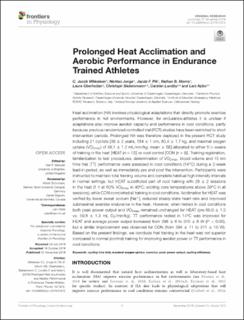| dc.contributor.author | Mikkelsen, C Jacob | |
| dc.contributor.author | Junge, Nicklas | |
| dc.contributor.author | Piil, Jacob F | |
| dc.contributor.author | Morris, Nathan B | |
| dc.contributor.author | Oberholzer, Laura | |
| dc.contributor.author | Siebenmann, Christoph | |
| dc.contributor.author | Lundby, Carsten | |
| dc.contributor.author | Nybo, Lars | |
| dc.date.accessioned | 2020-03-31T08:34:23Z | |
| dc.date.available | 2020-03-31T08:34:23Z | |
| dc.date.created | 2020-01-26T16:05:16Z | |
| dc.date.issued | 2019 | |
| dc.identifier.citation | Frontiers in Physiology. 2019, 10, (1372) | en_US |
| dc.identifier.issn | 1664-042X | |
| dc.identifier.uri | https://hdl.handle.net/11250/2649582 | |
| dc.description | Frontiers is fully compliant with open access mandates, by publishing its articles under the Creative Commons Attribution licence (CC-BY). Funder mandates such as those by the Wellcome Trust (UK), National Institutes of Health (USA) and the Australian Research Council (Australia) are fully compatible with publishing in Frontiers. Authors retain copyright of their work and can deposit their publication in any repository. The work can be freely shared and adapted provided that appropriate credit is given and any changes specified. | en_US |
| dc.description.abstract | Heat acclimation (HA) involves physiological adaptations that directly promote exercise performance in hot environments. However, for endurance-athletes it is unclear if adaptations also improve aerobic capacity and performance in cool conditions, partly because previous randomized controlled trial (RCT) studies have been restricted to short intervention periods. Prolonged HA was therefore deployed in the present RCT study including 21 cyclists [38 ± 2 years, 184 ± 1 cm, 80.4 ± 1.7 kg, and maximal oxygen uptake (VO<sub>2max</sub>) of 58.1 ± 1.2 mL/min/kg; mean ± SE] allocated to either 5½ weeks of training in the heat [HEAT (n = 12)] or cool control [CON (n = 9)]. Training registration, familiarization to test procedures, determination of VO<sub>2max</sub>, blood volume and 15 km time trial (TT) performance were assessed in cool conditions (14°C) during a 2-week lead-in period, as well as immediately pre and post the intervention. Participants were instructed to maintain total training volume and complete habitual high intensity intervals in normal settings; but HEAT substituted part of cool training with 28 ± 2 sessions in the heat (1 h at 60% VO<sub>2max</sub> in 40°C; eliciting core temperatures above 39°C in all sessions), while CON completed all training in cool conditions. Acclimation for HEAT was verified by lower sweat sodium [Na<sup>+</sup>], reduced steady-state heart rate and improved submaximal exercise endurance in the heat. However, when tested in cool conditions both peak power output and VO<sub>2max</sub> remained unchanged for HEAT (pre 60.0 ± 1.5 vs. 59.8 ± 1.3 mL O<sub>2</sub>/min/kg). TT performance tested in 14°C was improved for HEAT and average power output increased from 298 ± 6 to 315 ± 6 W (P < 0.05), but a similar improvement was observed for CON (from 294 ± 11 to 311 ± 10 W). Based on the present findings, we conclude that training in the heat was not superior compared to normal (control) training for improving aerobic power or TT performance in cool conditions. | en_US |
| dc.language.iso | eng | en_US |
| dc.rights | Navngivelse 4.0 Internasjonal | * |
| dc.rights.uri | http://creativecommons.org/licenses/by/4.0/deed.no | * |
| dc.subject | cycling time trial | en_US |
| dc.subject | maximal oxygen uptake | en_US |
| dc.subject | exercise | en_US |
| dc.subject | peak power output | en_US |
| dc.subject | cycling efficiency | en_US |
| dc.title | Prolonged Heat Acclimation and Aerobic Performance in Endurance Trained Athletes | en_US |
| dc.type | Peer reviewed | en_US |
| dc.type | Journal article | en_US |
| dc.description.version | publishedVersion | en_US |
| dc.source.pagenumber | 9 | en_US |
| dc.source.volume | 10 | en_US |
| dc.source.journal | Frontiers in Physiology | en_US |
| dc.source.issue | 1372 | en_US |
| dc.identifier.doi | 10.3389/fphys.2019.01372 | |
| dc.identifier.cristin | 1782212 | |
| cristin.unitcode | 209,4,4,0 | |
| cristin.unitname | Idrettshøgskolen Innlandet | |
| cristin.ispublished | true | |
| cristin.fulltext | original | |
| cristin.qualitycode | 1 | |

